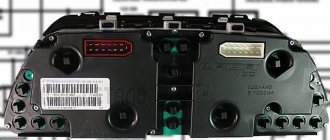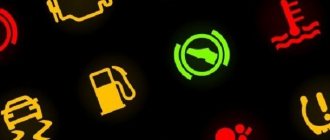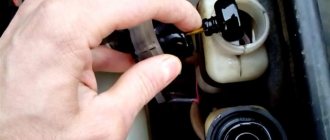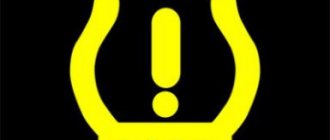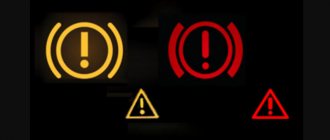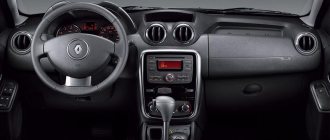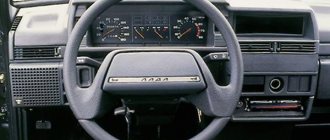The number of systems in cars is constantly growing, new technologies, assistants and autopilots are being developed. Automakers often implement similar technologies into their vehicles, but under their own names, so a problem with the same system may show up with different icons on the dashboard. In this material, we have compiled a catalog of indicators (icons) on car dashboards with detailed descriptions and explanations of their designations.
As a rule, green icons indicate the activation of some kind of automotive system, yellow and red indicate malfunctions. Red icons usually indicate more serious problems, or may indicate critical malfunctions in which the vehicle cannot be used.
Critical fault icons
Exclamation mark in a circle or the inscription Brake
The handbrake is on or there is a problem with the brake system (low brake fluid level, excessive pad wear, etc.), or a malfunction of one of the sensors.
Blue or red thermometer (thermometer)
Problems with engine temperature. A red thermometer means overheating - you must immediately turn off the engine, a blue thermometer means low engine temperature - you should warm up the engine before driving. These errors can also occur due to faulty temperature sensors.
Oiler with drop (kettle)
Typically indicates low engine oil pressure or a faulty oil pressure sensor. Sometimes this icon also means low oil level, although another designation is more common for the latter (see below).
Oiler with waves or inscriptions Oil level, Min, Sensor
Low engine oil level or faulty oil level sensor. Check the oil dipstick. Some of these icons may also indicate low engine oil pressure.
Battery or battery labeled Main
If the battery light is on, this means the battery is low, the battery is not charging due to a malfunction of the generator or a problem in its circuit. On hybrid cars it is more often found with the inscription Main.
Engine with STOP inscription or simply STOP inscription
This warning light means it is necessary to stop the engine immediately. On VAZ cars this usually means low brake fluid or oil level. The appearance of such an icon may be accompanied by a sound signal. It is better to stop the movement.
In what other cases does the exclamation mark light up?
If the fuel pressure is at a normal level, and the brake pads do not cause any complaints, but the indicator warning sign is still on on the panel, then what could this mean? In such a case, it is worth assuming that something is happening with the wiring: the system most likely began to open. If any wire leading to the pad sensor breaks, a lamp lights up, signaling their wear. In this case, of course, you can short-circuit the wires yourself, but then you will have to climb under the car every 2000-3000 km to check their condition. So it’s better to go to the service.
Security system malfunctions
Inscription Airbag, SRS, “pregnant man”
Error in SRS (Supplemental Restraint System) - auxiliary restraint system, refers to passive safety systems. The SRS light comes on if there is a problem with the airbags or their circuit. Motorists call the first sign “pregnant man”; this error often occurs due to oxidation of contacts in the circuit to the airbags; on some cars this is a “sore”.
Man with a belt, the inscription Side Airbag Off
Indicates that the front passenger airbag is deactivated. This may be a sign of a malfunction in the circuit, a problem with the airbag, or simply the front passenger airbag is disabled - modern cars have such a function - with the airbag disabled, you can transport children in front in child seats. The switch is usually located on the right side of the dashboard.
ABS inscription, Antilock, sliding car badge
All of these indicators indicate a problem with the ABS anti-lock braking system. Typically, there are sensors for this system in each wheel and a malfunction of any of the sensors will cause such an error. Diagnosis required.
Exclamation mark in a red triangle
One of the doors, trunk or hood is open, the driver or passengers are not wearing seat belts, or other emergency situations occur. The indicator can be combined with a beeping buzzer.
Exclamation mark in orange triangle
Problems with the vehicle's electronic stability control (ESP) system.
Inscription RSCA OFF
The side curtain airbags, which are activated when the vehicle rolls over, are disabled. Typically, SUVs are equipped with a button with the ability to disable this system - with strong body roll, the curtains can work.
PCS inscription or car with key
The collision avoidance system or pre-crash safety system - PCS (Pre-collision system or Pre-crash system) is disabled.
Key or car icon with lock
The standard alarm or immobilizer is activated. After the key is recognized, it should go out. If this does not happen, the key is not recognized or there is another problem.
Red circle
A red circle or ball means the anti-theft system has been activated, resulting in the engine being blocked. After the key is recognized, it should go out; if this does not happen, there may be a problem with the immobilizer or the key is not recognized.
What to do if you can’t find or fix the problem
There are situations when you cannot cope with the problem yourself, or the reason for the indicator on the instrument panel cannot be found. In this case, you need to seek help from specialists at the service station or experienced friends, if you have any.
Inept interference with electronics can be disastrous for a computer and other devices; expensive additional repairs can result - it’s not worth the risk. Call mobile repairmen, a tow truck, or go to a car repair station on your own, if this is possible and does not pose a risk to life. Pay for the work of professionals and do not forget to get a guarantee coupon for the work performed.
Automatic transmission errors
Exclamation mark in a red or yellow gear
A yellow gear error means problems with the automatic transmission and its operation in emergency mode. A red gear can also mean problems with the power unit.
Inscriptions AT or A/T Oil Temp, wrench, thermometer in gear
The inclusion of one of these indicators means there are problems with the automatic transmission - AT (Automatic Transmission). Most often this means overheating of the gearbox oil or a malfunction of the temperature sensor. Yellow lights warn of problems; when the red light comes on, it is better to stop driving. Also, such lights may indicate problems with the transmission control unit.
Car axle with levers
It can mean various problems with transmission components, including overheating of the gearbox, problems with the clutch, and more. For the exact value for your specific vehicle, please refer to your owner's manual.
Gearbox and Auto inscription
This light can only come on on cars with an automatic transmission. Indicates that there are problems with the automatic transmission - low oil level, high temperature, problems with the automatic transmission control unit or sensors.
Up arrow
Indicates the need to change gear to a higher one.
CVT inscription
Error in continuously variable transmission or CVT (Continuously Variable Transmission).
Inscription 2nd STRT
Some cars with an automatic transmission have a second-gear start feature that helps you get started in difficult conditions (icy conditions). When this light is illuminated, the system is activated.
Shoe in a circle with brackets
An indicator that is installed on cars with automatic transmission. Reminds you to press the brake pedal before shifting into gear.
Car icon with wrench
May indicate problems with the engine, transmission or immobilizer. For exactly what this light means in your car, see its instruction manual.
PWR inscription
This light comes on when the “Power” mode is activated in a car with an automatic transmission. In this mode, upshifts occur at higher rpm than usual in order to obtain maximum power.
Inscription O/D Off or Over Drive Off
This light indicates that the OverDrive system is disabled. Available only on cars with an automatic transmission; when this system is turned off, the car will not upshift to save fuel. If there is an OverDrive system, there should also be a button to turn it off.
According to the results
A burning symbol in the form of an exclamation mark on the instrument panel indicates the occurrence of problems, most often with the brakes, so ignoring its appearance is dangerous. You should immediately look for the cause in any way available to you and fix the problem. Even if the problem is not in the brakes themselves, but in the accompanying system (for example, ABS), this is also dangerous - you can fly into a ditch during sudden braking, or the pads can jam tightly. Remember the main thing: preventing a problem in a timely manner is easier and cheaper than later raking mountains of sad consequences that are not always possible to correct.
Other errors on the instrument panel
Waves in a circle and brackets on both sides
The indicator indicates low brake fluid level.
Steering wheel with exclamation mark
Problems with the power steering system.
Red letter P in a circle with brackets
The hand (parking) brake is applied. On newer vehicles, the handbrake is automatically applied when the vehicle is stopped.
Yellow exclamation mark in a circle with brackets
Problem with the Electronic brakeforce distribution (EBD) system. This is a more advanced system than ABS and it operates constantly, and not just during emergency braking.
Yellow circle with broken brackets
Pad wear indicator. The information comes from consumable sensors, which are gradually erased along with the pads until the electrical circuit is broken - at this moment such a light comes on. You need to replace the pads or check the sensors.
Lightning in a circle with brackets
The system has detected a problem with the electric parking brake.
Low tire pressure indicator
Such bulbs can be installed in the dashboards of cars with tire pressure sensors. Low pressure is reported (pressure drop of more than 25% from nominal).
Engine icon with Check inscription, Check Engine inscription, EPC
Such errors indicate problems with the engine. The light only comes on when the engine is running. This could be sensor malfunctions, poor fuel-air mixture, and so on. Check Engine means “check the engine” in English. The error may be accompanied by uneven engine operation, poor traction, jerking when moving, and so on. Motorists often jokingly call this mistake “Jackie Chan.” The inscription EPC (Electronic Power Control) can be seen on cars of the Volkswagen Group; it means problems with ignition or engine control.
Inscription ENG A-Stop
This indicator can be seen on cars with a start-stop system. The green icon lights up when the engines are turned off, the yellow one indicates a malfunction with this system.
Engine with down arrow
Indicator of poor engine traction (reduction in engine power).
Icon with Greek letter λ (lambda) in a triangle
The system has detected a malfunction in the oxygen sensor (the so-called lambda probe). There may be several such sensors in a car; they are involved in adjusting the air-fuel mixture. If there is a malfunction, there may be increased fuel consumption or poor traction.
Catalyst indicator
Problems with the neutral catalyst of the exhaust system - overheating or other malfunction.
Gas cap or Check Gas Cap
The gas cap is open or air is entering the fuel system. The inscription Check Gas Cap translates as “check the tank cap”
Letter "i" in a circle
An informational message may also remind you that there is some other error.
Book with letter "i"
We recommend that you read the vehicle's operating instructions.
Low coolant level indicator
These lights, in one form or another, indicate a low level of coolant in the system or a malfunction of the sensor responsible for monitoring its level - most often the sensor contacts are oxidized.
Zipper and two brackets
Error in the electronic throttle control system.
The car is on a lift, the inscriptions Maint REQD, Service, Oil change
Basically, these lights indicate the end of the maintenance interval and remind you to visit a service center for an oil change or service. Usually the interval is set at the dealership, and the error is cleared there using a special diagnostic device. Some of these errors can sometimes mean serious damage, read your vehicle's owner's manual.
Dots and arrows
When this light comes on, it indicates that the engine air filter does not pass air well and needs to be replaced.
Night view inscription
Night view translates as “night vision” - indicates problems with the night vision system, most likely the infrared sensors or their circuit are faulty.
VGRS inscription
Problems with variable ratio steering. This technology is called VGRS (Variable Gear Ratio Steering).
Inscriptions ETCS, ECT PWR, EML
Problems with systems ETCS or ETC (Electronic Throttle Control System, Electronic Throttle Control) - electronic throttle control, ECT (Electronically Controlled Transmission) - electronically controlled transmission system, EML (Elektronische Motorleistungsregelung) - electronic engine management system.
Malfunctions of stabilization systems
Inscriptions Trac, DTC, VSA, TCS
Such lights indicate problems with the traction control system, which can have different names - TRAC (Traction and Active Traction Control), DTC (Dynamic Traction Control), TCS (Traction Control System). The traction control system is connected to the brake system, so if there are problems with the latter, there may also be DTC errors.
KDSS inscription
A KDSS (Kinetic Dynamic Suspension System) error means that the kinetic dynamic suspension system is faulty.
Uphill/downhill icons
The illumination of these indicators is for informational purposes and displays the status of the auxiliary systems for ascent or descent. They may be present on vehicles whose equipment list includes start-up assistance and constant speed maintenance systems.
ESP BAS inscriptions
A malfunction has been detected with the emergency braking assistance system ESP (Electronic Stability Program) and stabilization BAS (Brake Assist System). Both systems are connected to each other, so the light bulb shows the abbreviations of both systems at once.
Inscriptions VDC OFF, DSC OFF, VCS OFF
All these lights mean that the Stability Control system is turned off, which is responsible for leveling the car in emergency situations (for example, when skidding). Different manufacturers call these systems differently.
Exhaust brake indicator
If this icon lights up green, it means the exhaust brake system is activated. If it lights up yellow, it is disabled or faulty. The switch is usually located on the steering column switch.
Exclamation mark in triangle and arrow
The vehicle's dynamic stabilization system - Vehicle Stability Control (VSC) or Dynamic Stability Control (DSC) - is disabled.
Exclamation mark in a triangle and the inscription 4x4
Malfunction in the all-wheel drive system.
Arrow wheel or BAS lettering
Problems with the car's emergency braking assistance system BAS (Brake Assist System); this system is also popularly called “braking assist”. An error in this system leads to the disabling of the ASR traction control system (Automatic Slip Regulation, Acceleration Slip Regulation, Anti-Slip Regulation).
Inscription IBA OFF
The IBA (Intelligent Brake Assist) system does not work. Responsible for automatically activating the braking system in the event of a possible collision.
Sliding machine
Sensors have detected wheel slippage, in which case the stabilization system can be activated.
Two cars collided and a sprocket
This Brake Assist indicator warns you of the possibility of a collision with another vehicle. If the error is constantly on, there is a malfunction.
Sliding machine with a wrench, in a triangle, the inscription SLIP
The stabilization system is faulty; under normal conditions it does not interfere with driving, but in an emergency, “artificial intelligence” will not help.
Warning
Of course, in this case, it is best to find the nearest service center to check the car's braking system. By the way, on the way to an unscheduled inspection, you need to be prepared for the fact that you will have to press the pedal harder if you need to brake. And also to the fact that the free play of the said pedal will increase, as will the braking distance of your car. By the way, if the icon lights up along with the ABS indicator, then when braking, premature locking of the rear wheels is possible.
Special icons on the dashboard
Key icons
The key icon indicates the different states of the electronic key in the car - its presence (green) or absence (red). Monochrome displays may display these states slightly differently.
Key and key icons with lightning
The icon in the form of a key fob means that the car has detected the electronic key. The same icon with a lightning bolt indicates the need to replace the battery in the key fob.
Snowflake or SNOW inscription
The mode of movement on snow or ice, the so-called Snow Mode, is activated. This system is usually installed on cars with an automatic transmission.
Car in a red triangle
Typically, this light may come on when driving on cruise control when the radar detects a close approach to the vehicle in front or detects an obstacle.
Man and door icon
The Easy Entry function for comfortable entry of the driver and passengers is activated. Usually knows how to adjust the position of the body and seats for ease of entry.
Inscriptions Cruise, SET, ACC, car icons with speedometer
All of these indicators indicate the activation of the adaptive cruise control system (ACC, Adaptive Cruise Control). If the light blinks, this means there are problems with the system.
Rectangle with arrows icon
The heated rear window is on.
Inscriptions HOLD, AUTO HOLD
The Automatic Brake Hold system is activated, which prevents the vehicle from moving after a complete stop. To unlock the brakes you need to press the gas pedal.
Sport and Comfort inscriptions
Informs the driver about the selected shock absorber stiffness mode (also called driving modes, suspension stiffness).
Height high inscription
Indicates that the maximum body height has been reached on vehicles with air suspension.
CMBS inscription
Problems with the CMBS (Collision Mitigation Brake System) system.
Dynamic suspension malfunction
There are problems with the dynamic suspension system. Usually the appearance of this light indicates a problem, but it is not prohibited to drive the car. If this light turns red, the problem is critical and it is unsafe to continue driving.
Trailer icon or TOW inscription
Indicates activation of Tow Mode. This mode is recommended when using a trailer or when the trailer is heavily loaded.
Letter "P" with radar
Icon of the Park Assist parking assistant, which helps when parking. If this light is green, this means the system is activated; if it is yellow, there is a problem.
Car between the stripes, LKW, LDW inscriptions
Lane assist icon. It may be called differently by different manufacturers - LDW (Lane Departure Warning Indicator), LKA (Lane Departure Prevention), LKA (Lane Keeping Assist), respectively, and the designations on the icon may differ.
Start-Stop indicator
A fault has been found in the start-stop system.
Green badges with plants or ECO inscription
The icon indicates the activation of eco mode, which reduces fuel consumption.
Icons on the dashboard of hybrid vehicles
Battery icon or battery labeled Main
Indicates a problem with the HV main battery or high voltage circuit.
Car icon with exclamation mark
Electric drive problems are similar to Check Engine (check engine) for hybrid vehicles.
Battery icon with lightning
The vehicle's high-voltage battery is discharged.
Gas station and electric plug icon
The high voltage battery is low and needs charging.
Turtle icon in circle
Reducing battery power to low values.
Light bulb with electric plug
The battery is charging (connected to the electrical network).
EV or EV Mode inscriptions
The hybrid vehicle runs on electric power (EV Mode activated).
Car icon with signal icons
The sound system for warning pedestrians when a vehicle is approaching does not work. Such systems are installed on hybrid and electric vehicles due to the silent operation of the power plant, which is why pedestrians and other road users may not hear the vehicle approaching.
Car icon with signal icons
A malfunction in the power circuit of an electric vehicle may be accompanied by a decrease in the power of the power plant. The red color of the light indicates the criticality of the error; driving a car with such an indicator is not recommended.
What you can do yourself
Try removing the connector from the cap of the reservoir where the brake fluid is located, pull off the rubber boot from it and, if it appears wet from the fluid, blow it out and wipe it clean. Check to see if the exclamation mark has gone out. Put the connector on. If the indicator lights up again, then the level sensor is most likely faulty. It happens that brake fluid gets into the middle part of the cover and closes the contacts. To do this, you need to disassemble the lid, clean and dry it. A similar operation can be done at home.
Icons on the dashboard of cars with diesel engines
Light bulb with spiral
The glow plug heating is activated - this light comes on after turning the key in the ignition. It is recommended to wait until this light goes out before starting the engine.
DPF indicator
The Diesel Particulate Filter needs to be replaced. This filter is installed only on diesel cars and is designed to reduce the amount of soot in exhaust gases.
Exhaust gas cleaning agent low level icon
It is necessary to add AdBlue exhaust gas purification reagent. Its tank can be located under the hood, next to the gas tank filler neck, in the spare wheel niche of the trunk. The filler cap for the AdBlue tank is blue. In some countries this reagent is called AUS 32 (Aqueous Urea Solution 32) or DEF (Diesel Exhaust Fluid).
Exhaust icon
The maximum permissible level of exhaust gas emissions has been detected.
Icons for the presence of water in the exhaust
Sensors detected the presence of water in the fuel. High water levels in the fuel can cause damage to the injectors or engine. Also, these errors may indicate the need to service the fuel purification system.
EDC inscription
Problems with the electronic injection system in a car with an EDC (Electronic Diesel Control) diesel engine. The system receives from many sensors in the car; if any of them malfunctions, such an error may light up.
Error in the form of a cardiogram
Water in diesel fuel, sensor malfunction or electronic engine control systems are malfunctioning.
Inscription T-BELT
The T-BELT error means the timing belt needs to be replaced. Usually it lights up every 100,000 kilometers. The error can be reset using diagnostic equipment.

